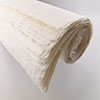Jan 06, 2022 (Nanowerk News) An international team of researchers from the University of Cologne (Germany), Radboud University Nijmegen (The Netherlands), the Ioffe Institute and the Prokhorov General Physics Institute (Russia) has discovered a new mechanism to control spin-lattice interaction using ultrashort terahertz (THz) pulses (terahertz means 1012 hertz). This...
Magnetic surprise revealed in ‘magic-angle’ graphene
Jan 07, 2022 (Nanowerk News) When two sheets of the carbon nanomaterial graphene are stacked together at a particular angle with respect to each other, it gives rise to some fascinating physics. For instance, when this so-called “magic-angle graphene” is cooled to near absolute zero, it suddenly becomes a superconductor,...
Heat rectification via suspended asymmetric graphene nanomesh
Jan 07, 2022 (Nanowerk News) Currently, researchers at the Japan Advanced Institute of Science and Technology (JAIST) have demonstrated a promising asymmetric graphene nanomesh device that shows a high thermal rectification ratio at low temperatures. The experiment provides a practical guideline for developing a high-efficiency thermal rectifier based on graphene...
An optical chip improved by light
Jan 07, 2022 (Nanowerk News) Technology is increasingly moving towards miniaturization and energy efficiency. This also applies to electronic chips. Light, and optics more broadly, are functional in making compact and portable chips. Researchers from the Photonic Systems Laboratory, headed by Professor Camille Brès, have successfully applied a novel principle...
Graphene could replace rare metal used in mobile phone screens
Jan 07, 2022 (Nanowerk News) Researchers from Paragraf and Queen Mary University of London demonstrated the successful fabrication of an Organic Light-Emitting Diode (OLED) with a monolayer graphene anode, replacing ITO in organic light-emitting diodes (Advanced Optical Materials, "Wafer-Scale Graphene Anodes Replace Indium Tin Oxide in Organic Light-Emitting Diodes"). Indium...
How scientists are ‘looking’ inside asteroids
Jan 07, 2022 (Nanowerk News) Asteroids can pose a threat to life on Earth but are also a valuable source of resources to make fuel or water to aid deep space exploration. Devoid of geological and atmospheric processes, these space rocks provide a window onto the evolution of the solar...
Exploration of new frequency frontiers
Jan 07, 2022 (Nanowerk News) When matter is irradiated by ultrashort laser pulses, excited electrons scatter on femtosecond timescales. A femtosecond is a millionth of a billionth of a second. Information about the scattering and other fast processes in the material can be extracted from the wave characteristics of transmitted...
Biotechnology could provide an environmentally more sustainable alternative to egg white protein production
Jan 07, 2022 (Nanowerk News) Egg white is one of the most important protein ingredients for the food industry. The first assessment of the environmental impact of egg white protein – ovalbumin – production by fungus Trichoderma reesei shows that the ovalbumin produced by precision fermentation reduced land use requirements...
Light-matter interactions at the atomic scale simulated on the world’s fastest supercomputer
Jan 07, 2022 (Nanowerk News) Lightâmatter interactions form the basis of many important technologies, including lasers, light-emitting diodes (LEDs), and atomic clocks. However, usual computational approaches for modeling such interactions have limited usefulness and capability. Now, researchers from Japan have developed a technique that overcomes these limitations. In a study...
Traditional Xuan paper inspires development of new high-haze transparent film
Jan 06, 2022 (Nanowerk News) Xuan paper, known as one of the Four Treasures of the Study, is an important carrier for traditional Chinese calligraphy and painting art, and it is also a precious cultural heritage of the Chinese nation. It has a history of more than 1,500 years and...










